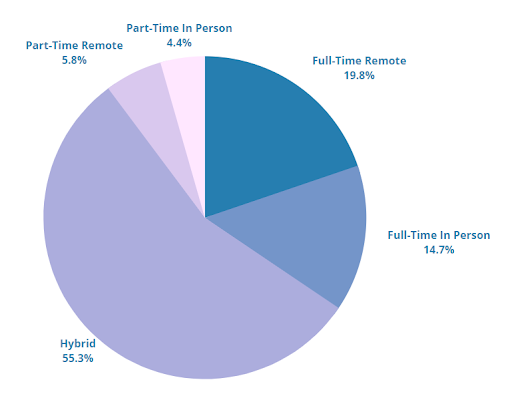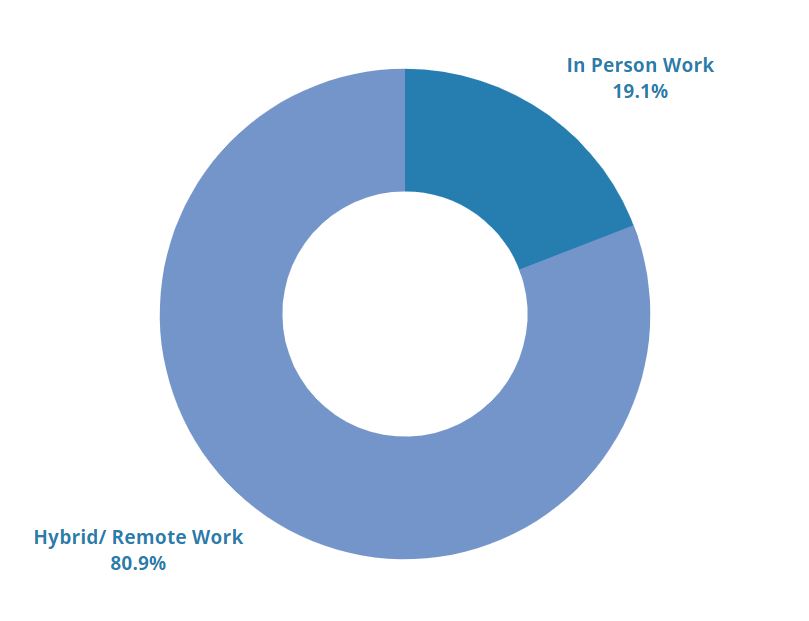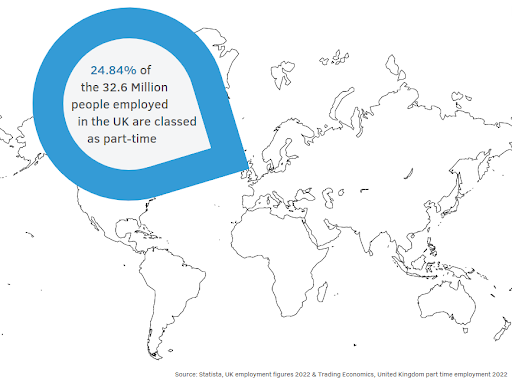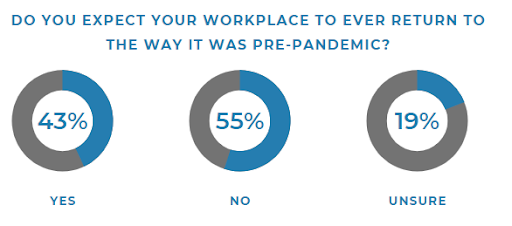 In May 2022, we conducted a poll of 450 office workers across the UK to determine their true working preferences. This poll was designed to inform us on a number of concepts related to the post-pandemic UK working landscape, with hybrid and various other working models receiving particular attention.
In May 2022, we conducted a poll of 450 office workers across the UK to determine their true working preferences. This poll was designed to inform us on a number of concepts related to the post-pandemic UK working landscape, with hybrid and various other working models receiving particular attention.
The most obvious and glaring takeaway from our poll was that more than half of respondents believe hybrid to be their ideal working arrangement. Prior to conducting this poll, we ensured that respondents were limited to individuals who had worked in an office environment prior to the pandemic, a group that we believe to be the most indicative of changing sentiments around in-person, remote, and hybrid working models. We posed many questions to these respondents regarding their pre-pandemic and post-pandemic working situations, as well as the ways in which their working preferences changed since the start of 2020. Results from related questions were seen to be in line with the 55% majority that indicated their preference for hybrid working arrangements for workers returning to the office.
To summarise relevant findings, this poll illustrated that (rounded to the nearest whole number):
- 55% of UK office workers see the hybrid model as their ideal working arrangement
- 20% of respondents indicated a preference for full-time remote work, highlighting that a sizeable number of UK office workers have no desire to return to their former office spaces
- On the other hand, 15% of workers polled believe that it’s ideal to return to the office full-time. A number which, despite being lower than the desire for full-time remote work, clearly illustrates support for more traditional working models
- The clear minority (10%) of those polled preferred to return to work in a part-time capacity. Of those who desired part-time work, there was a slight preference for purely remote (56%) when compared to purely in-person (44%) schedules

The Hybrid Working Model is in Vogue
There are a number of likely factors that can explain the preference for a hybrid working model seen in our poll. The pandemic served as a unique proving ground for the viability of remote work, whilst simultaneously providing UK workers with an opportunity to realise that they might have been taking the benefits of the office for granted. Prior to the pandemic, one would have wagered a guess that a lot of office employees would have jumped at the ideal of a full-time remote schedule. No commute! No need to wear business clothes each day! No need to deal with distracting office politics! These small perks attracted a lot of people and, when the pandemic came, a lot of workers embraced their new remote schedules with both hands. However, long periods of enforced isolation quickly began to highlight the innate benefits of office spaces, such as the rapport that’s formed between colleagues, the opportunities for networking, and the unique spark that comes from face-to-face interaction.
With these factors in mind, the fact that 55% of respondents perceive hybrid as their ideal working model comes as little surprise. This model is one that allows for the best of both worlds – where office workers are now free to dictate their own flexible working environment and mould it to meet their individual requirements. As previously mentioned, flexibility seems to be a common theme for the marketplace; serving as something offered by serviced offices and coworking spaces in order to meet demand, whilst also being sought out by business owners who’ve clearly received the memo that it’s no longer ‘business as usual’ for many employees. The general acceptance of flexible working has emboldened returned office workers to express their preference for hybrid, and for their employers and workspace providers to easily accommodate for it.
Demand for Fully Remote Working Reaches New Heights
It’s no surprise that a substantial number of UK office workers have expressed a desire to permanently adopt a remote working schedule. Two years is a long time in the business world, and it certainly seemed to drag longer for those who felt the bite of isolation. Being limited to working remotely for such a long time, it was always expected that many employees would develop an attachment to this type of work. Having had sufficient time to get used to a full-time remote schedule, and the benefits that it provides to work-life balance, the idea of returning to the office has been less than appealing to a lot of UK office workers.

The pandemic illustrated the viability of long-term remote work, particularly for businesses who might’ve previously pushed back against the concept of flexible working schedules. Now, it has become increasingly difficult for employers to deny requests for this type of model, as it has largely proven to be successful and maintain (or in some cases improve) levels of productivity. With this in mind, it’s unsurprising that UK office workers are seeing full-time remote schedules as a legitimate option, particularly when it facilitates a good work-life balance for many individuals who might have previously found themselves wasting time on long commutes.
19.1% of Respondents Would Prefer to Remain in the Office
In stark contrast to the combined 80.9% of respondents that indicated a preference for either hybrid or remote work, 19.1% of those polled adopted a more traditional approach – wanting to return solely to the office in a part-time or full-time capacity. The fact that this subset exists shouldn’t come as a surprise, as there are always outliers when conducting a study such as this. However, that this group of respondents comprises close to one-in-five of all those polled, shows that traditional in-office work still has its place in the current market.

A lot of people, including office workers, desire more structure and control within their working lives – something that can be seen to account for at least some of this subset’s preference for a full-time return to the office. Another potential reason for this predilection stems from a desire for face-to-face team building and socialisation between colleagues, two things that are known to have a profound impact on company culture. Despite the emergence of numerous tools and platforms that have dramatically improved collaboration and communication between remote workforces, it’s widely accepted that there is no real substitute for in-person interaction. The intangible benefits of face-to-face interaction are clear, with spontaneous conversations and general office chatter often serving to facilitate innovation. Additionally, the preference of these respondents could also hint towards a desire for clear separation of work and home, something that can be particularly beneficial for employees who struggle to differentiate between the two when working remotely.
Demand for Part-Time Working Arrangements Lower for Office Workers When Compared to the National Average
Only roughly 10% of those polled expressed a desire to work in a part-time capacity. This is in opposition to February 2022 UK labour statistics from Statista and Trading Economics, which highlight that 8.1 million of the 32.6 million people currently employed in the United Kingdom are employed in a part-time capacity. There are numerous reasons that could explain this disconnect. Firstly, our study is restricted to office workers and doesn’t factor in the large number of individuals working in retail, hospitality, and other industries that often employ part-time workers. In addition, many part-time workers may be unsatisfied with working in this capacity, only temporarily working part-time as they complete studies, raise young children, or look for other work. That our respondents expressed only a 10% combined desire for a part-time work arrangement is probably indicative of the proportion of the UK’s working population that is employed part-time permanently, with no present desire to make the jump to full-time if given the choice.

Of these workers who prefer part-time working arrangements, 56.5% indicated a desire for remote work, with the remaining 43.5% favouring an in-person schedule. These numbers align almost perfectly with those seen from respondents in support of full-time work, which saw 57.4% favouring remote work and 42.6% preferring to return in-person. Extrapolating these results out to the wider population, we can infer that, when given a choice between the two, the majority of UK office workers would choose to work remotely.
What does Hybrid Working Mean for the Future of the Office?
Despite the death of the office being predicted by countless commercial property pundits and industry insiders, such drastic change to the UK working landscape has failed to manifest. Recent reports from industry bodies and major publications tell a different tale – in which traditional office spaces are evolving to serve as collaborative hubs that sit at the intersection of in-person and remote working models. Featuring fewer desks, more social spaces, exciting new amenities, and a renewed focus on employee experience, the office of the future has already begun to appear across the country.
That’s not to say that these initial predictions were wholly illogical during the heights of the COVID-19 pandemic, which forced most companies to operate in a limited capacity, transition to fully remote schedules, or shutter up completely. Uncertainty swirling around lockdown end-dates and potential for additional mandates made it completely acceptable to hedge against the idea of the office ever returning to how it was pre-pandemic.
Standing in direct opposition to these beliefs were a number of experts who, in hindsight, were savvy in their outlooks for the future of the workspace. These individuals foresaw evolution within these spaces – but nothing so drastic as the landscape of work being altered to forego physical offices altogether. Office providers with this belief worked tirelessly throughout the pandemic to transform their facilities to suit a workforce that was poised to demand flexible working practices, altered design elements, and a new set of unique amenities. These changes ultimately manifested through more homely office decor, improved video conferencing technology, and increased proliferation of casual break-out areas, communal spaces, hot desks, and self-contained work pods.
Buoyed by their early adaptation, these providers have found the most success in the post-pandemic office climate. The general office space market has re-emerged to demand flexible and hybrid working options – with shorter-term rentals providing peace of mind to employers and sole traders who are stepping back into physical workspaces.

Instead of the foretold death of the office occurring due to continued remote work dominating post-pandemic, the broadly observed reality is now, instead, a hybrid one – where businesses comprise their workforce of a mixture of in-house and remote work. Though COVID initially forced businesses’ adaptation to remote, a lot of workers admitted to eventually coming to prefer this work type, at least for part of their week. COVID not only necessitated restriction and adaptation, but innovation – with the development of processes and utilities to facilitate remote work. And these innovations can be seen to have continued utility post pandemic in the world of hybrid working.
Compared to Australia and some parts of the United States, which have much more recently come out of a period of regular and lengthy lockdowns, statistics derived from our May 2022 study of UK office workers can stand up as more indicative of long-term preferences. The UK saw a return to normalcy months prior to other Western nations, allowing workers to largely become accustomed to the state of the new working landscape. The fact that 19% of respondents are eager to return to the office in a part-time or full-time capacity speaks to continued demand for more ‘traditional’ workspace, however, this figure is expected to continue to shrink as more and more businesses adopt hybrid or remote working models.
Do UK office workers ever expect the workplace to return to pre-pandemic norms?
While the statistics above have made it abundantly clear that UK office workers are currently demanding a new type of working environment than the one offered to them prior to the pandemic, we thought that it would be prudent to support this notion by asking them the question directly. Towards the tail-end of our poll, we asked respondents whether they expected their workplace to ever return to the way that it was pre-pandemic.
- 55.33% of those polled, a virtually identical number as those who outlined a preference for hybrid work, answered no.
- 28.22% said that they expected the office to return to the status-quo.
- 16.44% indicated that they were unsure.

When examined against the numbers of polled workers who desire new, non-traditional working arrangements, these findings come as little surprise. The desire for hybrid working schedules, improved design features, additional perks, and state-of-the-art amenities is something that we’ve clearly identified through this analysis. However, the relatively high percentage of individuals who stated that the workplace will return to pre-pandemic norms goes to show that, at least in some instances, the evolution of the workplace and adoption of successful hybrid working practices was already in motion leading up to the pandemic. This isn’t surprising, especially considering businesses in fields such as IT and digital marketing often don’t require their employees to be physically present, and haven’t for some time.
This presents a unique perspective when evaluating the pre- and post-COVID working environments, one that places less emphasis on the role of the pandemic in changing employee demands and more emphasis on the idea that we were already travelling down the path that we currently find ourselves on.
Final Thoughts

The writing was on the wall for a lot of business pundits in the months out of lockdown. Common belief stated that work as we knew it had changed, with the expectations and demands of new and existing employees shifting in response to the events of the pandemic. Brick and mortar office space providers quickly jumped to service these changing proclivities, adapting their offerings in the months leading up to the return to the office. Developed to entice, excite, and recapture the interest of workers who had spent the better part of two years at home, these workspaces were met with quick adoption rates and unique lease agreements. The hybrid model is now in vogue, satisfying the demands of top talent and providing businesses with the agility to scale their involvement and the peace of mind required in a post-pandemic working world.
When conducting our poll we aimed to gather information from a sample size that was large enough, and targeted enough, to provide results indicative of the larger UK office working population. Whilst not perfect, the information gathered from our poll clearly confirmed our suspicions, namely the fact that there is a distinct preference for hybrid working arrangements amongst UK office workers. However, what truly served as a surprise was the significant proportion of respondents who indicated preferences for other types of work – particularly the almost 15% who expressed a desire to return to the office full-time.
Hybrid work is undoubtedly the future of work, but if this study has gone to show anything, it’s that it’s far too early to write off the office space as a relic of the past. Employee demands and sought-after trends can quickly change in the face of world events and shared workplace sentiments. A lot of businesses are still looking back on the events of the pandemic and conducting analysis to determine the full impact that remote had on productivity before committing to a specific hybrid working policy. Expect to see the working landscape continue to evolve in the UK over the coming years, as businesses oscillate between in-person and remote schedules to determine the model that works best for their unique requirements.
For more deep dives into workplace statistics and general office insights, you can visit:
Most Desired Employee Perks for UK Office Workers (2022 Poll)
London Office Market Sees Highest Level of Occupier Activity Since Before the Pandemic
How to Deal with the Stress of Returning to the Office after a Long Layoff
10 Ways to Improve Office Morale
An Overview of Coworking Spaces in London
How to Value a Commercial Property and Determine Rent in London
